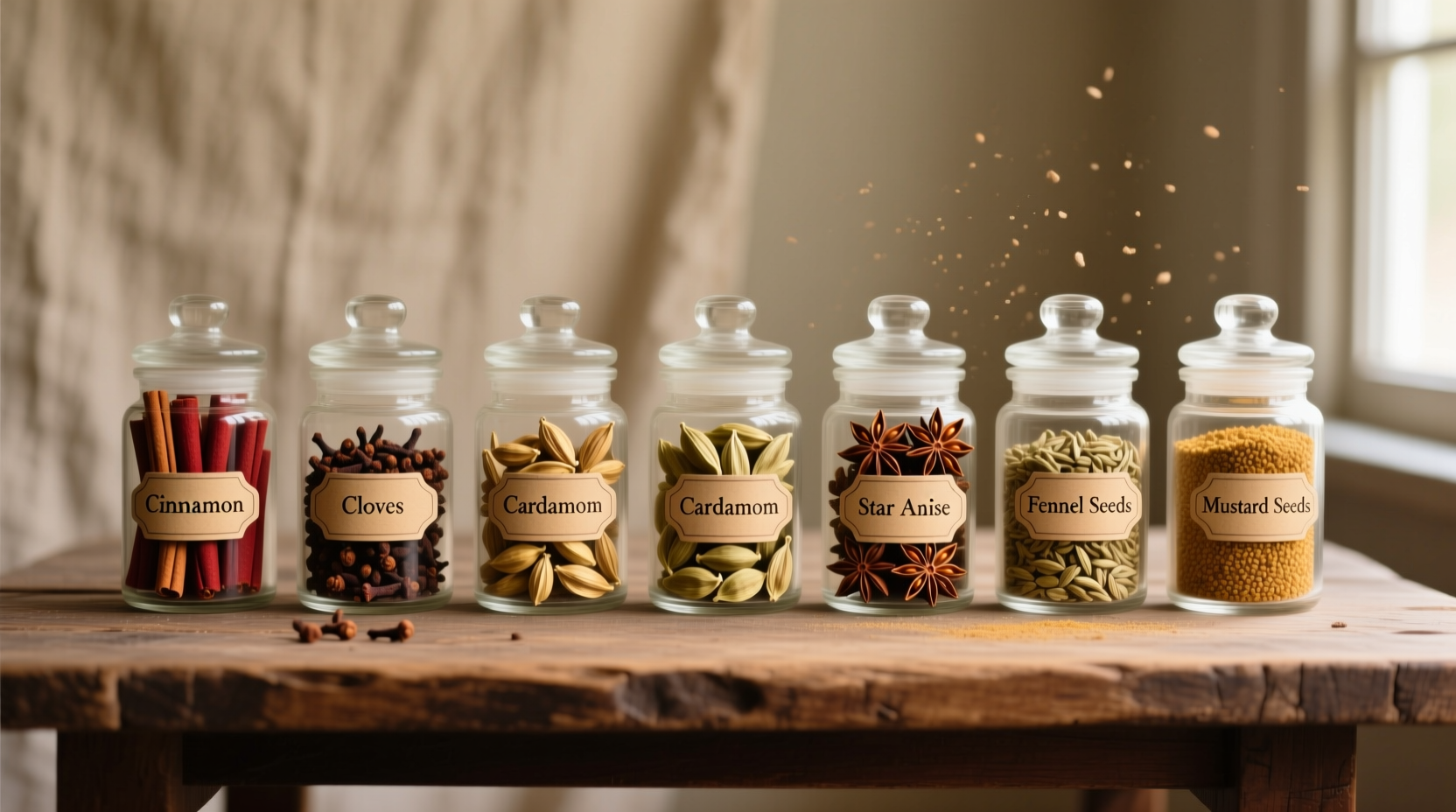Understanding what defines a spice transforms how you approach cooking, preserves cultural traditions, and connects you to centuries of global trade history. This guide delivers clear definitions, practical usage tips, and the scientific basis behind these culinary essentials—helping you make informed choices in your kitchen today.
The Scientific and Culinary Definition of Spices
Botanically speaking, spices are secondary metabolites produced by plants that serve protective functions in nature. In culinary terms, spices refer to dried plant parts used primarily for flavoring, coloring, or preservation. The key distinction lies in their origin: spices come from non-leafy parts of plants including seeds (coriander), roots (ginger), bark (cinnamon), fruits (peppercorns), and flower buds (clove).
Spices differ from herbs in both origin and chemical composition. While herbs contain volatile oils that dissipate quickly, spices contain more stable aromatic compounds that withstand prolonged cooking. This chemical stability explains why spices like cumin or turmeric maintain their flavor integrity in slow-cooked dishes where fresh herbs would lose potency.
| Characteristic | Spices | Herbs |
|---|---|---|
| Plant Origin | Non-leafy parts (seeds, roots, bark) | Leafy parts of plants |
| Chemical Stability | High (withstand heat/cooking) | Low (volatile oils dissipate) |
| Flavor Intensity | Generally stronger | Generally milder |
| Storage Life | Longer (1-4 years) | Shorter (weeks-months) |
How Spices Transformed Global History
The spice trade fundamentally reshaped world geography, economics, and cultural exchange. Historical records from the National Archives of India document spice routes dating back to 2000 BCE, when black pepper traveled from South India to Mesopotamia. The quest for direct access to spice-producing regions drove European exploration, leading to Vasco da Gama's 1498 voyage to India and subsequent colonial expansions.
Spice Trade Evolution Timeline
- 2000 BCE: Early spice routes connect India with Mesopotamia
- 1st Century CE: Roman Empire imports 3,000 tons of black pepper annually from India
- 1271-1295: Marco Polo documents extensive spice markets in Asia
- 1498: Vasco da Gama reaches India by sea, bypassing Arab intermediaries
- 1602: Dutch East India Company forms, monopolizing spice trade
- 18th Century: European powers transplant spice plants to colonies
- Present Day: Global spice market valued at $14 billion annually
Practical Applications in Modern Cooking
Understanding what constitutes a spice helps you use these ingredients more effectively. Professional chefs at the Culinary Institute of America emphasize three critical usage principles:
- Timing matters: Add whole spices early in cooking to extract maximum flavor, while ground spices work best added midway through the cooking process
- Heat activation: Toasting whole spices before grinding releases essential oils—try heating cumin seeds in a dry pan for 60 seconds before use
- Proper storage: Keep spices in airtight containers away from light and heat; whole spices maintain potency for 3-4 years while ground spices last 1-2 years
Food science research from the University of Massachusetts confirms that fat-soluble spice compounds like curcumin (in turmeric) become significantly more bioavailable when cooked with oils. This explains why traditional Indian recipes often begin with "tempering" spices in hot oil before adding other ingredients.

Contextual Boundaries: When Spice Knowledge Matters Most
While basic spice knowledge benefits all cooks, certain situations demand deeper understanding:
- Recipe adaptation: Substituting spices requires understanding flavor profiles—cardamom cannot replace cumin despite both being "warm" spices
- Dietary restrictions: Some spice blends contain hidden allergens (curry powder often includes nuts)
- Medical interactions: Turmeric affects blood thinners, while cinnamon in large quantities impacts blood sugar regulation
- Cultural authenticity: Traditional dishes require specific spice varieties (Mexican oregano differs significantly from Mediterranean oregano)
Essential Spice Reference Guide
These eight foundational spices represent the building blocks of global cuisines. Each entry includes flavor profile, primary culinary applications, and substitution guidance:
- Black Pepper: Pungent, woody notes; enhances all savory dishes; substitute with long pepper for similar heat
- Cinnamon: Sweet, warm, complex; essential in baking and Middle Eastern savory dishes; cassia makes acceptable substitute
- Cumin: Earthy, nutty, slightly smoky; backbone of Mexican, Indian, and Middle Eastern cuisines; no direct substitute
- Coriander: Citrusy, floral, mild; balances heat in curries and chili; fennel seed offers partial substitute
- Turmeric: Earthy, slightly bitter, vibrant yellow; essential in curries and mustards; saffron provides color but different flavor
- Cloves: Intensely sweet, pungent, warming; used sparingly in baking and braises; allspice offers distant approximation
- Nutmeg: Warm, sweet, slightly peppery; enhances dairy-based sauces and baked goods; mace provides similar flavor
- Paprika: Varies from sweet to hot; adds color and depth to stews and rubs; chili powder substitutes with added heat
Preserving Spice Quality and Potency
Research from the American Spice Trade Association confirms that improper storage causes 70% of home cooks to use degraded spices. Follow these evidence-based practices:
- Store in opaque, airtight containers away from stove and sink
- Buy whole spices when possible and grind as needed
- Test potency by rubbing between fingers—if aroma is weak, replace
- Keep spices away from direct sunlight (reduces potency by 50% in 6 months)
- Label containers with purchase date to track freshness
Frequently Asked Questions
What's the difference between a spice and an herb?
Spices come from non-leafy plant parts like seeds, roots, or bark, while herbs come from the leafy parts of plants. Spices generally have more stable flavor compounds that withstand cooking, whereas herbs contain more volatile oils that dissipate quickly.
How can I tell if my spices are still fresh?
Rub a small amount between your fingers and smell it. Fresh spices will have a strong, distinctive aroma. If the scent is weak or musty, the spice has lost potency. Whole spices typically maintain freshness for 3-4 years, while ground spices last 1-2 years when properly stored.
Why do some recipes call for whole spices instead of ground?
Whole spices retain their essential oils longer and provide more complex flavor development when toasted or simmered. They release flavors gradually during cooking, creating layered taste profiles that ground spices can't achieve. Many professional chefs toast whole spices before grinding them for maximum flavor extraction.
Can I substitute one spice for another in recipes?
Substitution depends on the spice's role in the dish. Some spices like cumin have distinctive flavors with no direct substitutes, while others like cinnamon can be replaced with similar warm spices. When substituting, consider whether the spice provides heat, sweetness, earthiness, or floral notes, and choose a replacement with similar flavor characteristics.











 浙公网安备
33010002000092号
浙公网安备
33010002000092号 浙B2-20120091-4
浙B2-20120091-4